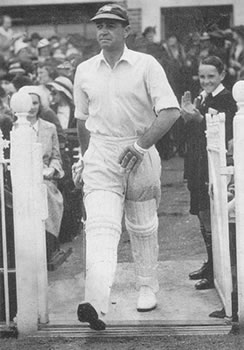Walter Hammond – The Way it Was
Martin Chandler |
This account of the last appearance of the great batsman is taken from a recently published book ‘The Way It Was’. We are grateful to Author and Publisher Stephen Chalke for allowing Cricket Web to feature this on the site.
36. The Return of the King
Wally Hammond of Gloucestershire WCM, JULY 2003
Monday 26 May 2003. A Bank Holiday and a day off for our county cricketers.
How different it was fifty years ago – when every Secretary prayed for Bank Holiday sunshine and traditional rivalries were resumed: from the Roses match in the North to the West Country encounter of Somerset and Gloucestershire.
In 1951, with the post-war attendance boom in decline, Gloucestershire announced that the great Walter Hammond would be returning for the August Bank Holiday match at Bristol. And despite overnight rain, according to the Bristol Evening World, the rationed folk of the city ‘rolled up to Ashley Down in their thousands, hoping to see the glories of the years between the wars recaptured.’
‘Glo’shire are batting, Hammond’s number four,’ went the word down the line.
Five years had passed since Hammond had last stepped out from the Bristol pavilion, scoring 214 against Somerset on another August Bank Holiday Saturday. Now he stood in the dressing room and shook hands with a new generation: Tom Graveney and Arthur Milton, the 18-year-old John Mortimore and the Gloucester new boy ‘Bomber’ Wells. The generation who had found inspiration in his exploits.
‘It was like standing in the presence of God,’ Bomber Wells says. ‘You can’t describe it, he was such a legend. He was 48 and looking much older because of the way he’d looked after himself – or not looked after himself. He smiled and shook hands. And I realised what large hands he had, and his forearms were huge like legs of pork.’
For the crowd the morning passed with no sight of their King. ‘The courtiers,’ the Evening World reported, ‘in the form of Emmett and Milton, displayed batsmanship of such quality that they seemed to appreciate that this was a regal occasion and were seeing that the stage was set for the appearance of the Old Master.’
Both made centuries but, after the dismissal of Emmett and Graveney, the moment came and the packed crowd rose to its feet in ovation. For Arthur Milton, the not-out batsman, it was a special moment. ‘The first cricket I’d watched was in 1946, on my way home from school, and Wally was playing.’
Horace Hazell, Somerset’s tubby slow left-armer, held the ball, and his first delivery rapped Hammond on the pad. ‘There was an agonising split second as Hazell made a very confident appeal.’
In his prime the great man was never dominated. ‘If you managed a maiden at him,’ Kent’s Doug Wright quipped, ‘it made your season.’ But here, for eighteen minutes, he groped for his first run.
‘A lot of people in the pavilion,’ John Mortimore recalls, ‘wouldn’t watch till he got off the mark.’
‘I just sat in the dressing room,’ Tom Graveney tells. ‘I couldn’t watch any of it.’
‘It was all rather embarrassing,’ Somerset’s Eric Hill says. ‘There he was. A great giant who had bestridden everything, struggling like a starter. Just struggling. Looking awful.’
In later years Hazell liked to tell how he fed him half-volleys outside the off-stump out of sympathy, but this is not how Eric recalls it. ‘He hit him several times on the pad. They looked unlikely, but Horace screamed at them all.’
Hazell had bowled to him here before the War, when Hammond had hit Somerset for centuries four summers running. He had bowled to him in 1946 when he hit 214. ‘He’d suffered all right,’ Eric says. ‘Whenever Hammond missed, Horace appealed – and he wasn’t that sort of bloke usually.’
‘Wally never said a word to me,’ his partner Arthur Milton recalls.
Arthur was a fleet-footed winger with Arsenal in winter, and without thinking he called a quick single, only to turn in horror to see his ageing partner well short of his ground as the throw came in. ‘I thought, ‘What have I done? I’m going to get lynched.”
The ball missed the stumps, but the agony continued. ‘It was terribly sad. I longed to see him do well. But there he was, cursing quietly as he mistimed balls he once hammered.’
After fifty minutes, a restless Hammond advanced down the track to the left-arm Hazell and was bowled ‘all over the shop’. His comeback was over, with just seven singles recorded in Monty Cranfield’s copperplate handwriting in the scorebook.
In the bar that evening Horace Hazell smiled quietly. He had taken eight wickets, but there was only one of them on his mind. Eric Hill still recalls his words: ‘I owed that bugger that one.’
Hammond stood at slip for a while on the Monday, then retired with lumbago. Three months later he emigrated to South Africa.
In June they are celebrating his centenary in Bristol, a month after John Mortimore celebrates his 70th birthday. ‘Sometimes I tell people I played with Wally, and they look at me. ‘God, you’ve aged well,’ they say.’
You can read Cricket Web’s review of The Way It Was here.





Leave a comment